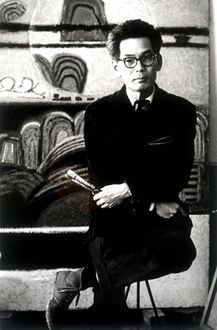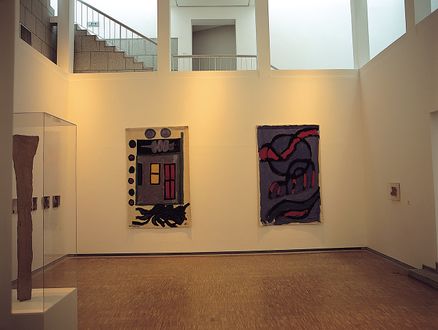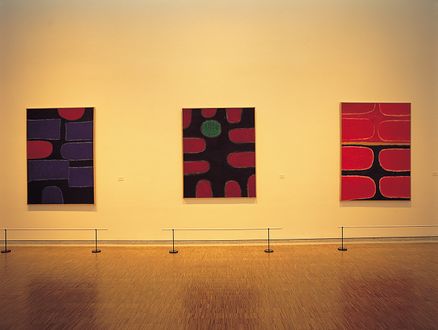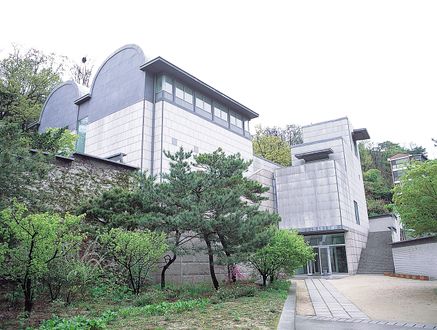"The Artist that Harmonized Korean Tradition and Modernity - Whanki Kim"의 두 판 사이의 차이
| 2번째 줄: | 2번째 줄: | ||
|Article= | |Article= | ||
}} | }} | ||
| − | “Suhwa” Whanki Kim (김환기, 1913-1974) was a modernist painter who became considered representative of 20th century Korean art. He was a pioneer of abstract art and combined traditional Korean aesthetic with Western modernism. Furthermore, his paintings brought oriental intuition together with occidental logic and displayed both distinctly Korean characteristics and modernity. | + | “Suhwa” [[Whanki Kim]] (김환기, 1913-1974) was a modernist painter who became considered representative of 20th century Korean art. He was a pioneer of abstract art and combined traditional Korean aesthetic with Western modernism. Furthermore, his paintings brought oriental intuition together with occidental logic and displayed both distinctly Korean characteristics and modernity. |
| − | Whanki Kim’s works can be divided into three periods: first, the period he studied in Japan; second, the period between the Korean liberation and his departure to the United States; and third, the years he worked in New York. | + | Whanki Kim’s works can be divided into three periods: first, the period he studied in [[Japan]]; second, the period between the Korean liberation and his departure to the United States; and third, the years he worked in [[New York]]. |
| − | Kim studied in Japan from 1933 to 1937, founding an avant-garde art research center and joining an abstract art movement. The new abstract art introduced in Japan made a deep impression on him, and this is reflected in his Hibiki (1937) and Rondo (1938) that display futuristic elements and constructivist colours. He also submitted works to the inaugural show of the Free Painters Exhibition and held his first solo exhibition at the Agami Gallery. From 1946 to 1949, he served as a professor at the Seoul National University of Fine Arts. There, he formed a neorealist school and launched a new modernist movement. | + | Kim studied in Japan from 1933 to 1937, founding an avant-garde art research center and joining an abstract art movement. The new abstract art introduced in Japan made a deep impression on him, and this is reflected in his Hibiki (1937) and Rondo (1938) that display futuristic elements and constructivist colours. He also submitted works to the inaugural show of the Free Painters Exhibition and held his first solo exhibition at the [[Agami Gallery]]. From 1946 to 1949, he served as a professor at the [[Seoul National University of Fine Arts]]. There, he formed a neorealist school and launched a new modernist movement. |
In the second period which spans from Korea’s liberation in 1945 to his departure to New York, the works Moonlight and Sanwol are the most representative works. Simple lines and shapes came to symbolize mountains, trees, and the moon. For instance, rounds shapes that represent the moon and traditional Korean jars filled his canvas. | In the second period which spans from Korea’s liberation in 1945 to his departure to New York, the works Moonlight and Sanwol are the most representative works. Simple lines and shapes came to symbolize mountains, trees, and the moon. For instance, rounds shapes that represent the moon and traditional Korean jars filled his canvas. | ||
| − | The third period expands from his settling in New York to his death. In 1965, the artist attended the Sao Paulo Biennale in Brazil and was inspired by American abstract expressionist works that had become the mainstream. After the Biennale, he flew to the United States with the desire to concentrate on painting. He settled in New York and worked there until he died. | + | The third period expands from his settling in New York to his death. In 1965, the artist attended the [[Sao Paulo Biennale]] in Brazil and was inspired by American abstract expressionist works that had become the mainstream. After the Biennale, he flew to the United States with the desire to concentrate on painting. He settled in New York and worked there until he died. |
| − | With subtle alterations of colors, light and shade, and the use of splashed-ink effect, Whanki Kim created an oriental and mysterious cosmic space in his paintings. In Where and What Form Are We to Meet Again?, small dots of dark blue repeat endlessly in the entire canvas. Each dot is painted over several times, blurred and blotted in the process. The title of the work originates from | + | With subtle alterations of colors, light and shade, and the use of splashed-ink effect, Whanki Kim created an oriental and mysterious cosmic space in his paintings. In Where and What Form Are We to Meet Again?, small dots of dark blue repeat endlessly in the entire canvas. Each dot is painted over several times, blurred and blotted in the process. The title of the work originates from [[Kim Gwang-seop]]’s poem entitled “In the Night.” |
<gallery mode=packed heights=220px> | <gallery mode=packed heights=220px> | ||
| 25번째 줄: | 25번째 줄: | ||
=='''Related Articles'''== | =='''Related Articles'''== | ||
| + | *[[Whanki Kim]] | ||
| + | *[[Japan]] | ||
| + | *[[New York]] | ||
| + | *[[Agami Gallery]] | ||
| + | *[[Seoul National University of Fine Arts]] | ||
| + | *[[Sao Paulo Biennale]] | ||
| + | *[[Kim Gwang-seop]] | ||
=='''References'''== | =='''References'''== | ||
2017년 11월 28일 (화) 19:33 판
“Suhwa” Whanki Kim (김환기, 1913-1974) was a modernist painter who became considered representative of 20th century Korean art. He was a pioneer of abstract art and combined traditional Korean aesthetic with Western modernism. Furthermore, his paintings brought oriental intuition together with occidental logic and displayed both distinctly Korean characteristics and modernity.
Whanki Kim’s works can be divided into three periods: first, the period he studied in Japan; second, the period between the Korean liberation and his departure to the United States; and third, the years he worked in New York.
Kim studied in Japan from 1933 to 1937, founding an avant-garde art research center and joining an abstract art movement. The new abstract art introduced in Japan made a deep impression on him, and this is reflected in his Hibiki (1937) and Rondo (1938) that display futuristic elements and constructivist colours. He also submitted works to the inaugural show of the Free Painters Exhibition and held his first solo exhibition at the Agami Gallery. From 1946 to 1949, he served as a professor at the Seoul National University of Fine Arts. There, he formed a neorealist school and launched a new modernist movement.
In the second period which spans from Korea’s liberation in 1945 to his departure to New York, the works Moonlight and Sanwol are the most representative works. Simple lines and shapes came to symbolize mountains, trees, and the moon. For instance, rounds shapes that represent the moon and traditional Korean jars filled his canvas.
The third period expands from his settling in New York to his death. In 1965, the artist attended the Sao Paulo Biennale in Brazil and was inspired by American abstract expressionist works that had become the mainstream. After the Biennale, he flew to the United States with the desire to concentrate on painting. He settled in New York and worked there until he died.
With subtle alterations of colors, light and shade, and the use of splashed-ink effect, Whanki Kim created an oriental and mysterious cosmic space in his paintings. In Where and What Form Are We to Meet Again?, small dots of dark blue repeat endlessly in the entire canvas. Each dot is painted over several times, blurred and blotted in the process. The title of the work originates from Kim Gwang-seop’s poem entitled “In the Night.”
Related Articles
- Whanki Kim
- Japan
- New York
- Agami Gallery
- Seoul National University of Fine Arts
- Sao Paulo Biennale
- Kim Gwang-seop



